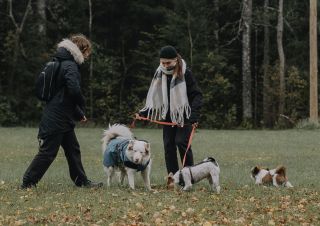Beauty
Does Having a Dog Make You More Attractive?
Women and men can get an attraction boost from a furry friend.
Updated November 14, 2023 Reviewed by Davia Sills
Key points
- Going out with a dog can make people seem more approachable to others.
- Dogs can serve as natural conversation-starters.
- Individuals who are accompanied by a dog may also appear more attractive.

Consciously or not, many people harbor ideas about what it means to be a dog person or a cat person. Whether or not these assumptions about pet-based personality traits are true remains to be seen. But a growing body of research has revealed that many find dog people especially approachable and attractive, and often in surprising ways.
In fact, scientific studies have illuminated the attractive perks of having a pooch. For one thing, dogs often serve as magnets that draw other people toward you when you’re out and about in your community. They give the impression that you are kind, caring, trustworthy, compassionate, and patient because you’re taking care of this cute creature.
Dogs also serve as natural conversation-starters, encouraging people to let down their guards long enough to at least say hello. While researching for our new book, The Purest Bond: Understanding the Human-Canine Connection, we discovered numerous studies about what’s been dubbed the “social facilitation effect” of having a dog or “the pet factor.”
In a 2023 study, Kaivalya and colleagues found that having a dog provided “social lubrication,” providing an easy topic of conversation or incentive to stop and talk among adults ages 55 and older in South Australia.
Besides being a conversation point, a dog’s presence somehow makes their owners seem more approachable. In a study by Wells, a woman was instructed to spend time in a park by herself or with a dog, a teddy bear, or a potted plant, while the behavior of 1,800 pedestrians passing by was tracked. When the woman was with a Labrador retriever puppy or an adult dog, more people smiled at her and spoke to her than when she was with a teddy bear or a potted plant.
To assess whether a dog’s demeanor plays a role in facilitating social interactions, McNicholas and Collis conducted a study in which they had people walk a dog that was highly trained to be standoffish and ignore attention from people passing by. They found that even with an aloof dog, the pooch’s presence increased the frequency of social interactions, particularly with strangers.

There also may be something intangible about a dog’s presence that makes the person they’re with seem more attractive. Research by Rossbach and Wilson found that when people viewed photographs of people pictured alone, with a dog, or with flowers, the participants rated those who were sitting or standing with dogs as more approachable and looking happier and more relaxed than the others. In another study, men were more successful at getting a woman’s phone number if they were accompanied by a dog.
Previously, research led by Tifferet found that when women read vignettes about men who have dogs and men who don’t, the women perceived the dog-owners as more attractive and nurturing with greater potential for a long-term relationship. Amazingly, this impression was formed without the women even meeting the men!
So the next time you take your dog for a walk, tune into the possibility that your pup may make you look attractive to other people and draw new people into your orbit. It really does happen. I, Stacey, can attest to this: I met my husband while we were walking dogs in our neighborhood.
Facebook image: TommyStockProject/Shutterstock
References
Golbeck, J., & Colino, S. (2023). The Purest Bond. New York, NY: Atria Books.
Kaivalya, M.L., Crozier, A.J., Nottle, C., and Young, J. (2023). More than dog walking: Pets as physical activity and social connection facilitators in the lives of retirement village residents. Human-Animal Interactions, 11:1, 1-10.
Wells, D.L. (2004). The facilitation of social interactions by domestic dogs. Anthrozoös, 17:4, 340-352.
McNicholas, J., and Collis, (2010). G.M. Dogs as Catalysts for Social Interactions: Robustness of the Effect. British Journal of Psychology. 91:1, 61-70.
Rossbach, K.A., and Wilson, J.P. (1992). Does a Dog’s Presence Make a Person Appear More Likable?: Two Studies. Anthrozoös, 5:1, 40-51.
Guéguen, N., and Ciccotti, S. (2015). Domestic Dogs as Facilitators in Social Interaction: An Evaluation of Helping and Courtship Behaviors. Anthrozoös, 21:4, 339-349.
Tifferet, S., Kruger, D.J., Bar-Lev, O., and Zeller, S. (2013). Dog Ownership Increases Attractiveness and Attenuates Perceptions of Short-Term Mating Strategy in Cad-Like Men. Journal of Evolutionary Psychology, 11:3, 121-129.


